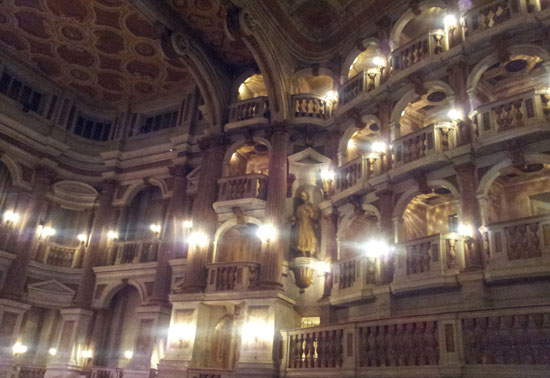Discovering Mantua
The journey to discover the most beautiful cities in Italy continues. Spring has arrived, the most favorable season for organizing short trips out of town, searching for treasures darte and pleasant locations where you can spend happy hours alone or in company.
We want to tell you about Mantua, a truly magical city that rises on an area lapped by the waters of the River Mincio, which, just north of the city, widens out, arranging itself into three lakes, coveted places for sports, boat crossings or walks along the green belt that runs along them.
 |
| The statue of Rigoletto |
Mantua was founded in Etruscan times and owes its name to the deity Mantu or perhaps the Greek soothsayer Manto; what is known for sure is that it was the much-loved home of Virgil and the scenic setting of Verdi’s opera Rigoletto. Mantua is also the city that boasts one of the most beautiful theaters in the world: inside the Accademia Virgiliana, built by the Bibiena family, the Teatro Scientifico is a small Baroque jewel that amazed even Mozart. It can also be said that Mantua is the city where opera was born with the notes of Monteverdi’s Orfeo played in the Ducal Palace.
The Ducal Palace is the most eloquent symbol of the grandeur of the Gonzaga family, born in later times it is a succession of rooms (about 500 rooms), courtyards and interior gardens over an area of more than 3 hectares that make it one of the grandest residences in Europe. A kind of summa of the Italian Renaissance from its beginnings to the Mannerist epilogue, as well as being a container darte housing paintings by Mantegna, Pisanello, Rubens, Tintoretto, rightly defined as a city within a city, so much so that the Basilica Palatina of Santa Barbara and the castle of San Giorgio are also part of it. The latter houses the famous Bridal Chamber painted by Andrea Mantegna from 1465. It is important to note the April 3 reopening after a period of closure for consolidation and restoration work following the 2012Emilia earthquake that caused a great deal of damage to the palace.
We therefore recommend a visit to this rich palace, taking advantage of this beautiful new addition that spring 2015 brings us. Then, if that is not enough, you could also pay a visit to the equally famous Palazzo Te, which stands outside the city center and was born precisely as a palace for court lozio, designed, built and decorated by Giulio Romano.
 |
| Sordello Square |
It is worth walking the stretch that leads from the city center (starting from the Ducal Palace) to Palazzo Te, thus passing in review the other distinguished monuments of Mantua: Piazza Sordello, a wide rectangle that overlooks the cathedral; Piazza Broletto and Piazza delle Erbe, the center of municipal life bordered by the Palazzo del Podestà and the Palazzo della Ragione, as well as by wide porticoes. In Piazza delle Erbe, always the place of merchants, next to the clock tower stands the oldest church in Mantua: the rotunda of San Lorenzo, commissioned by Matilda of Canossa.
The most sumptuous, imposing and symbolic church (studied in all architectural books) is the Basilica of SantAndrea designed (Renaissance) by Leon Battista Alberti and finished with a dome by Filippo Juvarra. In the crypt is preserved something comparable to the Holy Grail, two vessels containing the blood of Christ, collected during the crucifixion by the Roman centurion Longinus.
Continuing the ideal path between the two Gonzaga palaces we pass by the house of Mantegna, then to the Temple of San Sebastiano and the city museum of San Sebastiano, which in the past was another of the Gonzaga palaces; we then arrive at the so-called locality of Teieto where we can rest under the trees in the park surrounding the palace.
Having finished the journey into Mantuan art and architecture, the journey into its equally rich gastronomy can then begin. But for this we do not need words, just sit at the table in pleasant company and take advantage of the Lombard flavors of a rich and appetizing land.
Did you enjoy the episode? Let us know with your comments and if you want try to answer the usual three questions about the city. Enjoy your trip !!!
Question 1: Who was the flying Mantuan?
Question 2: What does Shakespeare have to do with Mantua?
Question 3: Where is Andrea Mantegna buried?
Trivia of the episode: It was in Mantua that Filippo Tommaso Marinetti premiered the Futurist Manifesto on April 6, 1911.
 |
| The Bibiena Theater |
 |
| The Rotunda of San Lorenzo |
 |
| The Exedra of Palazzo Te as seen from the Loggia |
 |
| The vault of the Mirror Gallery of the Ducal Palace |
 |
| The Giardino dei Semplici of the Ducal Palace |
Warning: the translation into English of the original Italian article was created using automatic tools. We undertake to review all articles, but we do not guarantee the total absence of inaccuracies in the translation due to the program. You can find the original by clicking on the ITA button. If you find any mistake,please contact us.



























